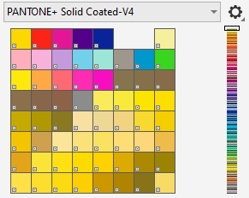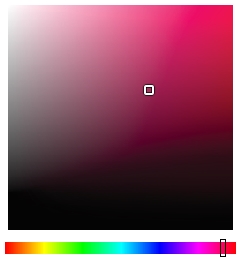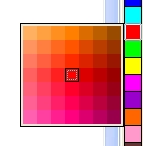Choose colors
You can choose fill and outline colors by selecting a color from the Document palette, custom color palettes, palettes from the Palette libraries, or color viewers. When you want to use a color that already exists in an object or document, you can sample the color by using the Color eyedropper tool to achieve an exact match.
For information about applying the colors you choose, see Uniform fills and Format lines and outlines. For information about saving colors for future use, see Color styles.
A color palette is a collection of color swatches. In some programs, color palettes are known as "swatch palettes."
In Corel DESIGNER, the default color palette is based on the primary color mode of the document. For example, if the document’s primary color model is RGB, the default color palette is also RGB. For more information, see Color models. You choose the default color model when you create a new drawing. You can open and use additional color palettes at any time.
You can choose both fill and outline colors by using the default color palette. The selected fill and outline colors appear in the color swatches on the status bar.
When you create a new drawing, the application automatically generates an empty palette, called the Document palette. It helps you keep track of the colors that you use by storing them with your document for future use. For more information, see Document palette.
Palette libraries and custom color palettes
The color palettes that are found in the Palette libraries cannot be edited directly. Some of them are provided by third-party manufacturers, for example PANTONE, HKS Colors, and TRUMATCH. It may be useful to have on hand a manufacturer’s swatch book, which is a collection of color samples that shows exactly what each color looks like when printed.
The PANTONE solid coated palette is an example of a color palette from the Palette libraries.
Some palettes found in the Palette libraries — PANTONE, HKS Colors, TOYO, DIC, Focoltone, and SpectraMaster — are collections of spot colors. If you create color separations when you print, each spot color requires a separate printing plate, which can significantly affect the cost of the printing job. If you want to use color separations but would like to avoid using spot colors, you can convert the spot colors to process colors when printing. For more information, see Color separations.
Custom color palettes can include colors from any color model, including palettes from the Palette libraries, such as a spot color palette. You can save a custom color palette for future use. For more information about working with custom color palettes, see Create and edit color palettes and Organize and show color palettes.
When you want to use a color that already exists in a drawing, palette, or on your desktop, you can sample the color to achieve an exact match. By default, you sample a single pixel from the drawing window.
Color viewers provide a representation of a range of colors by using either one-dimensional or three-dimensional shapes. The default color viewer is based on the HSB color model, but you can use this viewer to choose CMYK, CMY, or RGB colors. For information about color models, see Color models.
You can use web colors when you design documents that will be published to the web. With Corel DESIGNER, you can define web colors by using RGB hexadecimal values (for example, #aa003f).
If you choose a color that is out of the printer’s gamut, Corel DESIGNER allows you to replace it with a similar color that is in the printer’s gamut.
To choose a color by using the default color palette
You can display color values by pointing to a swatch.
To display color names instead of color values, click the Options flyout button at the top of the default palette, and click Show color names. This action undocks the default color palette and displays the color names.
An example of a pop-up color palette
To choose a color by using a color palette
Each spot color swatch on a color palette is marked with a small white square.
If you choose a color that is out of the printer’s gamut, Corel DESIGNER allows you to replace it with a similar color that is in the printer’s gamut. For more information, see To replace an out-of-gamut color with a reproducible color. For information about color correction, see Color management.
You should use the same color model for all colors in a drawing; the colors will be consistent and you will be able to predict the colors of the final output more accurately.
You can also access color palettes in the Color docker by clicking the Show color palettes button and choosing a palette from the list box. If the Color docker is not open, click Window
![]() Color.
Color.
To choose a fill color by using a color viewer
If you choose a color that is out of the printer’s gamut, Corel DESIGNER allows you to replace it with a similar color that is in the printer’s gamut. For more information, see To replace an out-of-gamut color with a reproducible color. For information about color correction, see Color management.
You should use the same color model for all colors in a drawing; the colors will be consistent and you will be able to predict the colors of the final output more accurately. It is preferable to use the same color model in your drawing that you will be using for the final output.
You can also access color models in the Color docker by clicking the Show color viewers button and choosing a color model from the list box. If the Color docker is not open, click Window
![]() Color.
Color.
To sample a color
In some cases, the sampled color may be an RGB or CMYK color that is the closest equivalent to the original color, rather than being a complete match.
To choose a web color
You can specify hexadecimal color values only when working with RGB colors.
If you type an invalid hexadecimal value, the color does not change.
You can view hexadecimal color values on the status bar.
You can also choose web colors from the Outline Pen dialog box (on the status bar, double-click the Outline pen button ) and the Edit Fill dialog box (on the status bar, double-click the Fill button
, and click the Uniform fill button
), which let you view and copy the hexadecimal equivalents of non-hexadecimal color values.



